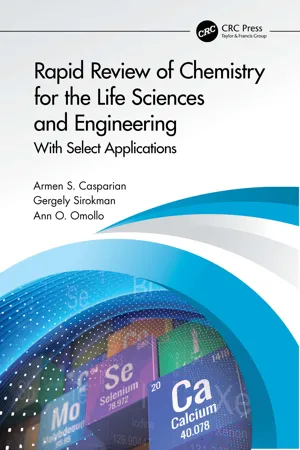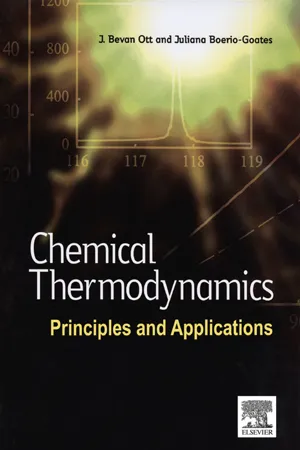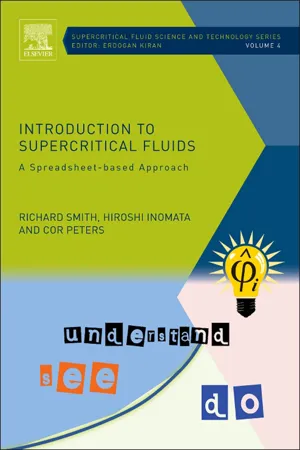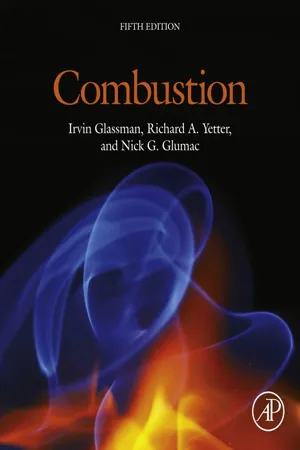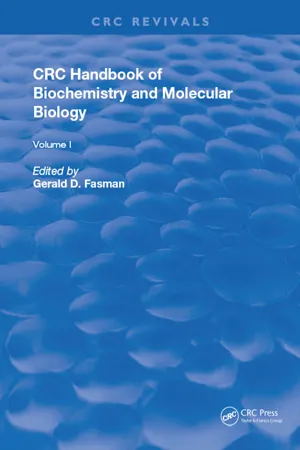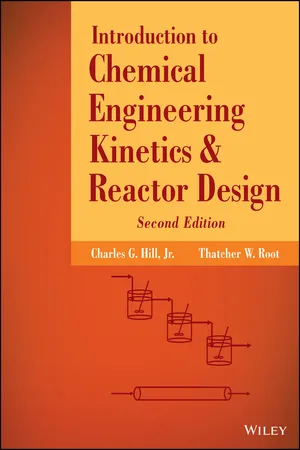Chemistry
Equilibrium Constant Kp
The equilibrium constant Kp is a measure of the extent to which a chemical reaction reaches equilibrium in terms of partial pressures of gases. It is defined as the ratio of the partial pressures of the products to the partial pressures of the reactants, each raised to the power of their respective stoichiometric coefficients, at equilibrium. A higher Kp value indicates a greater concentration of products at equilibrium.
Written by Perlego with AI-assistance
Related key terms
Related key terms
1 of 4
Related key terms
1 of 3
10 Key excerpts on "Equilibrium Constant Kp"
- No longer available |Learn more
- Steven Boone, Drew H. Wolfe(Authors)
- 2011(Publication Date)
- Collins Reference(Publisher)
c . The equilibrium constant equals the product of the molar concentrations of the products, each raised to the power that corresponds to their coefficients in the balanced equation, divided by the product of the molar concentrations of the reactants, each raised to the power corresponding to their coefficients. Equilibria that have reactants and products in more than one phase are heterogeneous equilibria, and those in which all substances in one phase are homogeneous equilibria.If the value of the equilibrium constant is greater than one (K c > 1), the magnitude of the numerator (products) of the equilibrium expression is larger than that of those of the reactants. If the value of K c is less than one (K < 1), the equilibrium concentrations of the reactants are usually greater than those of the products.Equilibrium constants for gas-phase equilibria are often expressed in terms of their partial pressures. This is known as the K p equilibrium constant. The following equation shows the relationship of K p to K c .K p = K c (RT) ΔnEquilibrium constants are obtained by measuring the equilibrium concentrations or partial pressures of each component of an equilibrium mixture and substituting these values into the equilibrium expression.Before a system reaches equilibrium, the concentrations or partial pressures are expressed in terms of the reaction quotient, Q . The expression for Q is in the same form as that of K . The value of Q is used to determine the direction from which an equilibrium develops. Concentration, pressure, volume, and temperature changes affect the concentrations of the components of a chemical equilibrium. Their effects may be predicted by the application of Le Chatelier’s Principle, which states that equilibrium systems tend to absorb any changes that may occur in such a way to reduce the change and return to a state of equilibrium.Test Yourself1. Write the equilibrium expression for the following. - eBook - ePub
Rapid Review of Chemistry for the Life Sciences and Engineering
With Select Applications
- Armen S. Casparian, Gergely Sirokman, Ann Omollo(Authors)
- 2021(Publication Date)
- CRC Press(Publisher)
c is discussed in more detail later in this section.Four points of caution regarding the use of this expression are noteworthy:- Only concentrations in units of molarity are permitted.
- Only species that have concentrations can appear. Thus, species in the solution state (aq) or in the gaseous state (g) are included, but species that are pure solids (s) or liquids (l) are not.
- Kc is a function of temperature (check the van’t Hoff Equation, Equation 4.5, later in this chapter).
- All concentrations substituted into this expression must be taken at equilibrium.
A reaction in which all species are present in the same physical state (e.g., all gases or all solutions) is called a homogeneous reaction, while a reaction in which species are present in more than one physical state (i.e., mixed physical states) is called a heterogeneous reaction. If all species in a reaction are present in the gaseous state, an alternative form of the equilibrium constant expression can be written as Kp :(4.3)K p=P GgP HhP AaP BbHere, P represents the partial pressure of each gas present at equilibrium. Any pressure unit is acceptable as long as it is consistent with the others and with the units of Kp , but atmospheres and torr are common.A formula to convert Kc to Kp , and vice versa, is as follows:where(4.4)K p=K c(R T)Δ n- T = the absolute temperature in Kelvins
- R = the gas constant to be used in units consistent with partial pressure
- ∆n = the change in the number of moles of gas, i.e., the total moles of product minus the total moles of reactant in the balanced reaction
Example 4.1: Expressing and Evaluating Kc and KpWrite the equilibrium constant expression Kc - eBook - ePub
Chemical Thermodynamics: Principles and Applications
Principles and Applications
- J. Bevan Ott, Juliana Boerio-Goates(Authors)
- 2000(Publication Date)
- Academic Press(Publisher)
is constant and we can write(9.7)and(9.8)Equations (9.7) and (9.8) define K , the equilibrium constant for the reaction.b It is sometimes referred to as the thermodynamic equilibrium constant . As we shall see, this ratio of activities can be related to ratios of pressure or concentration which, themselves, are sometimes called equilibrium constants. But K , as defined in equations (9.7) and (9.8) , is the fundamental form that is directly related to the free energy change of the reaction.9.1a Alternate Forms of the Equilibrium Constant
Alternative forms of the equilibrium constant can be obtained as we express the relationship between activities, and pressures or concentrations. For example, for a gas phase reaction, the standard state we almost always choose is the ideal gas at a pressure of 1 bar (or 105 Pa). Thusand(9.9)where the fugacity must be expressed in bars.c Substitutingfi= φi piinto equation (9.9) , where φi is the fugacity coefficient, gives(9.10)The ratio of pressures in equation (9.10) is known asKpand the ratio of fugacity coefficients is written asJφ. Hence,(9.11)At low pressures , and(9.12)for ideal gases, or gases at low pressure,piis related tocithe molar concentration in the gas phase bySubstitution into equation (9.11) gives(9.13)The expression is the concentration equilibrium constant K c , and equation (9.13) becomes(9.14)Finally,piis related toxi, the mole fraction in the gas phased by Dalton’s lawwhere p is the total pressure. Substitution into equation (9.11) gives(9.15)where(9.16)is the mole fraction equilibrium constant. In summary(9.17)and at low pressures when J φ = 1,(9.18)Alternate expressions can also be written for equilibrium constants in condensed phase reactions. For example, for the reaction - eBook - ePub
- Adrian Dingle, Derrick C. Wood(Authors)
- 2014(Publication Date)
- Research & Education Association(Publisher)
concentrations of reactants and products. In fact, they are very rarely the same numerical value.
5. Graphically, the concentrations of reactants and products can be represented as: i. For a product-favored reaction: ii. For a reactant-favored reaction: C. Quantitative TreatmentAll concentrations being constant (not changing) is not the same thing as concentrations being equal (all having the same value). This is a common misconception and one that you must not have.1. Equilibrium constants for gaseous reactions: Kp , Kci. Equilibrium constant relates the concentrations of reactants and products at equilibrium at a given temperature.For the general reaction: aA + bB cC + dDThe equilibrium constantProduct molar concentrations are in the numerator.Reactant molar concentrations are in the denominator.Each concentration is raised to the power of its stoichiometric coefficient in the balanced chemical equation.Pure solids and pure liquids (e.g., water) are not placed into the expression.The expression Kc indicates that concentrations are used (moles per liter).The expression Kp indicates that partial pressures are used (pressure units, often atm) and only gases are included.Examples1. N2 (g) + 3H2 (g) 2NH3 - eBook - ePub
- Louis Theodore, Francesco Ricci, Timothy Vanvliet(Authors)
- 2011(Publication Date)
- Wiley-AIChE(Publisher)
ILLUSTRATIVE EXAMPLE 14.3 Refer to Illustrative Example 14.2. Assuming that the reaction occurs at 1 atm pressure and some unknown temperature, express the equilibrium mole fraction of the four species in terms of ε.SOLUTION : In line with the definition of mole fraction, and noting that the equilibrium number of moles is n , one can write (since n = 5 - 2ε)Note that temperature plays no role in this calculation.ILLUSTRATIVE EXAMPLE 14.4 Refer to Illustrative Example 14.3. Calculate the partial pressures of the participating species if the pressure is 0.5 atm. Assume ideal gas behavior and ε = 0.3.SOLUTION : Based on the definition of partial pressureSince p = 0.5 atmSimilarly In accordance with the ideal gas law,The above results satisfy this equation.GAS PHASE REACTIONSThis chapter primarily addresses gas phase reactions. Although a rigorous, detailed presentation of this topic is beyond the scope of this chapter, this treatment is presented in the hope that it may provide at least an introduction to chemical reaction equilibrium for gas phase reactions. This topic finds widespread application in engineering calculations. The basic problem that remains is to relate K to understandable physical quantities and, as will soon be shown for gas-phase reactions, the term K may be approximately represented in terms of the equilibrium partial pressures or concentrations of the participating species.For homogeneous chemical reactions, it has been found to be convenient to introduce a new term referred to as the activity:(14.14)The activity is simply the ratio of the fugacity component in a mixture, i , to its value in the standard state f i 0 - eBook - ePub
- Jeffrey Gaffney, Nancy Marley(Authors)
- 2017(Publication Date)
- Elsevier(Publisher)
(2) is considered to be the reverse reaction of the same chemical equilibrium;•The value of the equilibrium constant for a forward chemical reaction K eq (f ) and the value of the equilibrium constant for the reverse chemical reaction K eq (r ) are the reciprocals of each other.K eqf = 1 /K eqr(8)This means that if a forward chemical reaction has a very large equilibrium constant, the reverse chemical reaction will have a very small equilibrium constant. Or, if a forward chemical reaction has a very small equilibrium constant, the reverse reaction will have a very large one.For cases where an overall chemical reaction can be considered stepwise, as the sum of two or more separate reactions, the equilibrium constant for the overall reaction can be determined from the equilibrium constants for each of the separate reactions. For example, nitrogen dioxide, a major air pollutant, is formed from the reaction of nitrogen and oxygen gas at high temperatures from the following reaction;N 2g +2O 2g ⇄2NO 2gwith the equilibrium constant expression;K eq=NO 22N 2O 22This overall reaction actually occurs in two very fast stepwise reactions: - eBook - ePub
Introduction to Supercritical Fluids
A Spreadsheet-based Approach
- Richard Smith, Hiroshi Inomata, Cor Peters(Authors)
- 2013(Publication Date)
- Elsevier Science(Publisher)
X < 0.(2) When is equal to zero, G is at a minimum and there is chemical equilibrium and this leads to the definition of the chemical equilibrium constant:(9.19)Equation (9.19) is usually rewritten to replace the chemical potential with fugacities or activities. Using the relationship for the chemical potential (Chapter 5 ):(9.20)or applying the standard state condition of 1 bar pressure:(9.21)Substituting Eq. (9.21) into Eq. (9.19) gives(9.22)Equating the terms and dividing by RT gives the definition of the chemical equilibrium constant in terms of the change in the Gibbs energy of the reaction or in terms of the product and reactant activities:(9.23)Equation (9.23) is usually written as two equations:(9.24)and(9.25)There are some important points regarding these equations. First, Eq. (9.24) is a function of temperature and the choice of the standard state of the substances. Since the standard state pressure is fixed at 1 bar according to the convention used in tables and the standard state of the species present is chosen by the type of calculation being performed, is a function of temperature only . Second, Eq. (9.25) is a function of T , P , X and the choice of the standard state of the substances. For a given choice of standard state for each species present, the standard state fugacity, - eBook - ePub
- Irvin Glassman, Richard A. Yetter, Nick G. Glumac(Authors)
- 2014(Publication Date)
- Academic Press(Publisher)
2 is present in large excess.2.6. The Partial Equilibrium Assumption
As will be discussed in the following chapter, most combustion systems entail oxidation mechanisms with numerous individual reaction steps. Under certain circumstances a group of reactions will proceed rapidly and reach a quasi-equilibrium state. Concurrently, one or more reactions may proceed slowly. If the rate or rate constant of this slow reaction is to be determined and if the reaction contains a species difficult to measure, it is possible through a partial equilibrium assumption to express the unknown concentrations in terms of other measurable quantities. Thus, the partial equilibrium assumption is very much like the steady-state approximation discussed earlier. The difference is that in the steady-state approximation one is concerned with a particular species and in the partial equilibrium assumption one is concerned with particular reactions. Essentially then, partial equilibrium comes about when forward and backward rates are very large, and the contribution that a particular species makes to a given slow reaction of concern can be compensated for by very small differences in the forward and backward rates of those reactions in partial equilibrium.A specific example can illustrate the use of the partial equilibrium assumption. Consider, for instance, a complex reacting hydrocarbon in an oxidizing medium. By the measurement of the CO and CO2 concentrations, one wants to obtain an estimate of the rate constant of the reactionThe rate expression isCO + OH → CO 2+ H(2.55)= −d ( CO 2)d t= kd ( CO )d t( CO )( OH )(2.56)Then the question is how to estimate the rate constant k without a measurement of the OH concentration. If one assumes that equilibrium exists between the H2 –O2 - eBook - ePub
Handbook of Biochemistry
Section D Physical Chemical Data, Volume I
- Gerald D Fasman(Author)
- 2018(Publication Date)
- CRC Press(Publisher)
We offer in this report several recommendations with the aim of increasing the usefulness of biochemical equilibrium data and coordinating the results of different investigators. These recommendations include a set of standard conditions which would facilitate the attainment of a common body of knowledge of a wide range of biochemical equilibria. This does not preclude the choice of special experimental conditions that may be appropriate for certain reactions; but whenever possible these reactions should also be studied under the recommended standard conditions. To avoid confusion in interpretation we also recommend standardization of terminology, symbols, and units in the presentation of such data.For other discussions of the presentation of numerical data and of thermodynamic data derived from experiments, we call the attention of the reader to guides prepared by CODATA1 and IUPAC.2PART I. STANDARD CONDITIONS FOR EQUILIBRIUM MEASUREMENTSTrue thermodynamic equilibrium constants are defined in terms of activities of the reactants and products. In many systems of biochemical interest it is not possible to evaluate the activities of all components. It is, therefore, frequently necessary to calculate equilibrium constants in terms of concentrations. The proper quotient of equilibrium concentrations is acceptably constant for many purposes, and will be referred to in this document as the concentration equilibrium constant, with the symbol Kc . However, it should be recognized that values for such equilibrium constants, Kc , and corresponding Gibbs energy changes,Δ, may not be truly constant as the composition of the system is changed.*G c o - Charles G. Hill, Thatcher W. Root(Authors)
- 2014(Publication Date)
- Wiley(Publisher)
2 to form HBr has a rate expression of the following form:3.0.19where k and k′ are constants at a given temperature and where the molecular species contained in parentheses refer to the concentrations of these species. This rate expression is discussed in more detail in Section 4.2.1.When one reactant is present in very large excess, the amount of this material that can be consumed by reaction is negligible compared to the total amount present. Under these circumstances, its concentration may be regarded as remaining essentially constant throughout the course of the reaction, and the product of the reaction rate constant and the concentration of this species raised to the appropriate order will also be constant. This product is then an apparent or empirical pseudo rate constant, and a corresponding pseudo reaction order can be determined from the resulting simplified form of the rate expression.3.0.2 The Reaction Rate Constant
The term reaction rate constant is actually a misnomer, because k may vary with temperature, the solvent for the reaction, and the concentrations of any catalysts that may be present in the reaction system. The term is in universal use, however, because it implies that the parameter k is independent of the concentrations of reactant and product species.The reaction rate is properly defined in terms of the time derivative of the extent of reaction [equation (3.0.1)]. One must define k in a similar fashion to ensure uniqueness. Definitions of k in terms of the various riwould lead to rate constants that would differ by the ratios of their stoichiometric coefficients. The units of the rate constant will vary depending on the overall order of the reaction. These units are those of a rate divided by an mth power of concentration (where m
Index pages curate the most relevant extracts from our library of academic textbooks. They’ve been created using an in-house natural language model (NLM), each adding context and meaning to key research topics.
Explore more topic indexes
Explore more topic indexes
1 of 6
Explore more topic indexes
1 of 4

